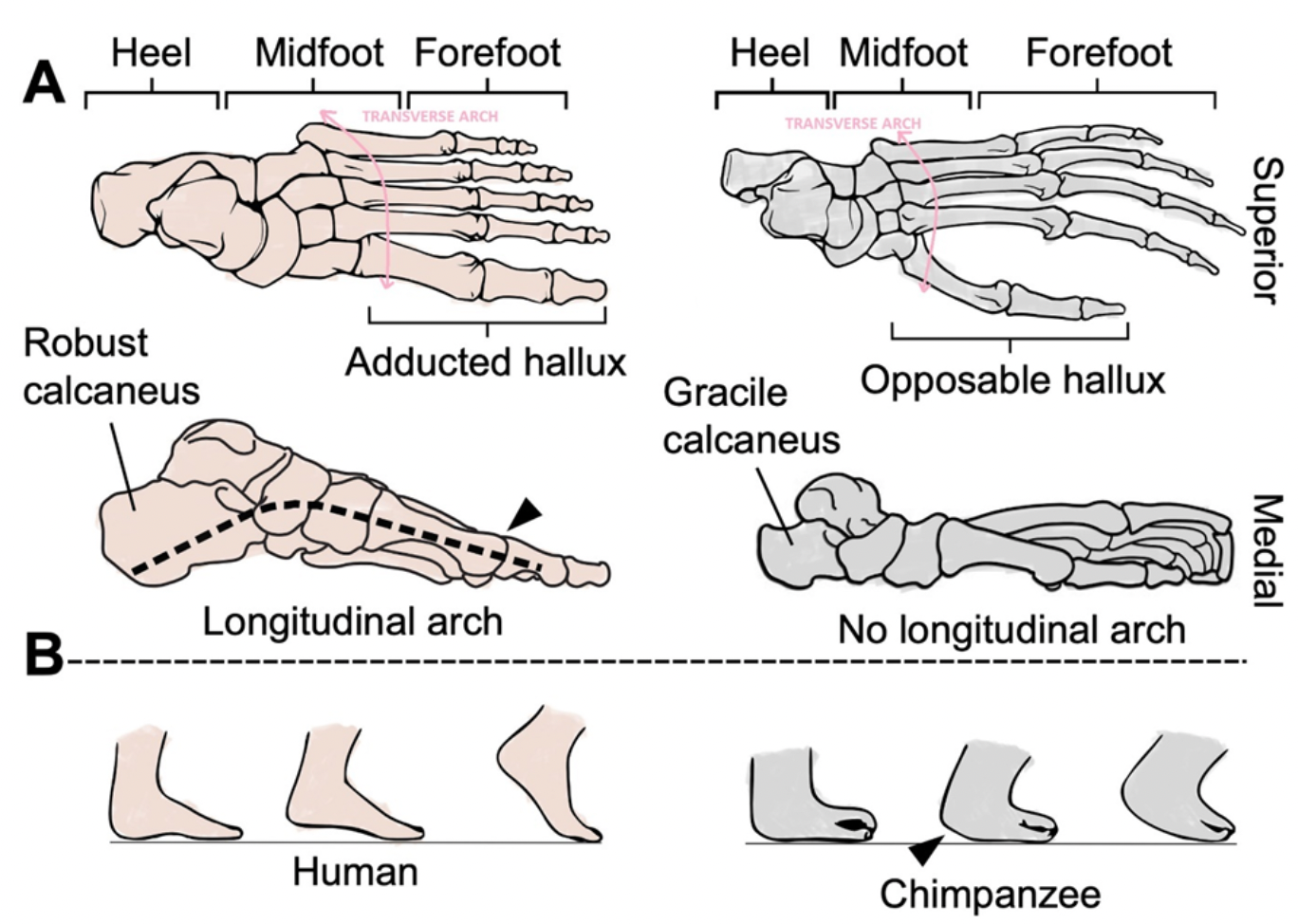This cleats aren’t just inspired by evolution, they’re built from it. Bipedalism changed everything: the structure of our knees, the arches in our feet, even how we absorb impact and stay balanced. Walking on two legs made us faster and smarter, but also more unstable and prone to injury. That’s why we designed our cleats based on the real biomechanics of human evolution, with features that support natural foot dynamics, absorb shock like the fat pads under our soles, and optimize energy like the metatarsal lever.
We also consider genetic variability (different foot shapes and arch types affect performance and injury risk). Our cleats adapt to that diversity, just like evolution did. Because these aren’t just boots. This is how humans were meant to move.

HUMAN EVOLUTION
Australopithecus: Early hominids had feet more similar to those of apes, with longer, more curved toes, adapted for climbing.
Homo erectus: The appearance of the longitudinal arch and a robuster structure indicate an adaptation for walking long distances in open terrain.
Homo sapiens: Modern feet display a structure optimized for bipedalism and efficient locomotion.
Specific Changes - Feet
The aligned toe of the foot facilitates balance and forward momentum when walking or running.
Reduction of the opposable hallux - Used to grasp branches, it is no longer prehensile and is aligned with the other toes, forming a rigid structure to support body weight and propel the body when walking or running.
Increased plantar arch - The foot was previously flatter; over time, longitudinal and transverse arches developed, allowing shock absorption, weight distribution, and spring-like action.
Increased robustness of the calcaneus and metatarsals - The heel (calcaneus) became stronger to withstand the force of impact during footfall. The metatarsals lengthened to improve leverage during the push-off phase.
Distribution of plantar fat - Pads of adipose tissue developed on the sole to cushion impact, which also inspired the inclusion of shock-absorbing materials in the boot.
Shortened toes - The toes were made shorter and straighter to promote stability and prevent injuries while running.
Possible causes
Forest disappearance and savannah predominance
Hands liberated by material manufacturing stimulating human brain and evolving it
Energy savings - A study published in the Proceedings of the National Academy of Sciences (PNAS) analyzed humans vs. chimpanzees. They put both species into walking machines and find out that humans only use 25% of the energy used by chimpanzees, as a result, they concluded that humans have a greater survival rate as they use less energy for movement.
GENETIC VARIABILITY
Gene frequency diversity is inherited polygenetically and through environmental adaptations over generations.
Foot anatomy: 26 bones (tarsus: heel (calcaneus) and ankle (talus); metatarsus: composed of five long bones that connect the tarsus to the phalanges; phalanges: the bones of the toes) - 33 joints - more than 100 muscles, tendons, and ligaments
Most common variations
Egyptian foot: Thumb is longest, the rest gradually taper
Greek foot: The index finger is the longest, especially in European populations
Square foot: The thumb, index finger, middle finger, and ring finger share similar lengths
Foot arch:
High (European and Asian populations; rocky terrain) - predisposes to problems such as plantar fasciitis
Normal
Flat (more common in African populations; soft terrain) - higher risk of ankle sprains and balance problems
Toe deformities: bunions and hammertoes (Examples)
Studies in athletes: Foot shape can influence athletic performance, and studies in runners have shown that certain foot types may be associated with a lower risk of injury.
APPLICATION TO CLEAT DESIGN
The analysis of the human foot and its bipedal evolution allows for the design of a cleat that:
Improves stability in a bipedal position that is more unstable than a quadrupedal position.
Distributes weight and absorbs impacts (foot arches, pads).
Optimizes energy during jumping and running (inspired by the metatarsal lever).
Prevents injuries by replicating the protective function of adipose tissue and natural biomechanics.
References
Mandujano Valdes, M., Del Carmen Sanchez-Perez, M., & Muñoz-Ledo Rabago, P. (2009). El bimetalismo del humano: Las aportaciones de Ferenc Katona. Casa del Tiempo. Retrieved August 5, 2025, from https://www.uam.mx/difusion/casadeltiempo/21_iv_jul_2009/casa_del_tiempo_eIV_num21_22_27.pdf
Povuv. (2024a, February 12). ¿Es hereditario el pie plano? ,¿cómo se hereda? Blog Biontech. https://www.biontechworld.com/blog/como-se-hereda-pie-plano?srsltid=AfmBOopURxxGkqGNLut0nON8rE7cTgNk3LEMZU9D7aqcfWzqABssuZk3
Povuv. (2024b, May 15). ¿Pueden los pies revelar tu linaje genético? Blog Biontech. https://www.biontechworld.com/blog/pueden-los-pies-revelar-tu-linaje-genetico?srsltid=AfmBOorF8yTV_pYdByjjJh03eAo2krGPVUllbCVV7xb7v13CfYAIOY69
Ruz Comas, S. (2024, February 8). ¿Por qué el Ser Humano es bípedo? Psicologia Y Mente. https://psicologiaymente.com/cultura/por-que-ser-humano-es-bipedo
Simek, J. (2021, November 17). Cuándo empezamos a caminar (y el misterio de qué hizo que nos paráramos). BBC News Mundo. https://www.bbc.com/mundo/noticias-59209693
Variabilidad genética. (n.d.). Genome.gov. https://www.genome.gov/es/genetics-glossary/Variabilidad-genetica
YUCAAN. (2020, September 7). El ser humano. Bipedismo y éxito biológico [Video]. YouTube. https://www.youtube.com/watch?v=enkxkMD0VXk